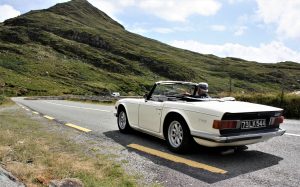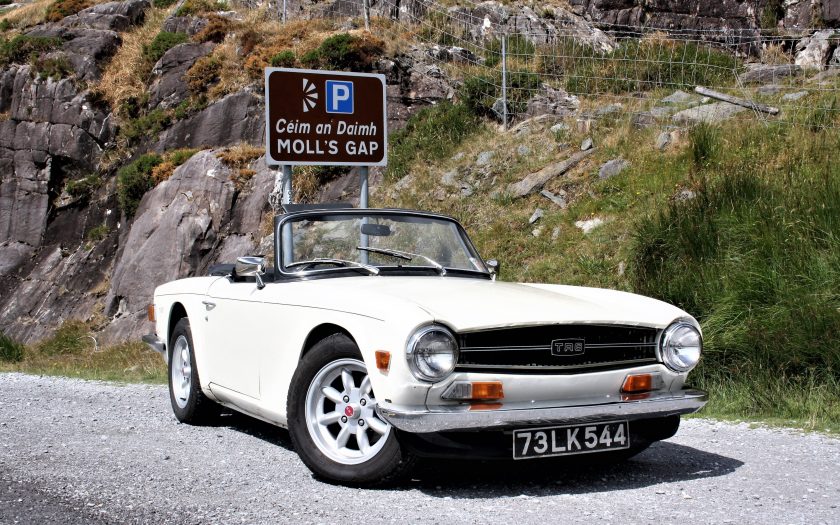Drive Molls Gap, Slea Head Loop, 90km
Car 1973 Triumph TR6
COUNTY LIMERICK, IRELAND: The charming locality of Adare is rated with justification as one of – if not the – prettiest villages in all of Ireland. If you’re looking for a base from which to tour and experience some of the Emerald Isle’s best parts, this is the place.
Just outside Adare is RetroVentures, awaiting our pick-up, is a white, well-maintained 1973 Triumph TR6, in US-specification of twin Stromberg carbs and 15-inch wheels. The trek south down the N21, 23 and 22 (in that order) leads us to County Kerry and Killarney, not an unpleasant drive for a major road, to be sure to be sure.

The TR6 and I are getting on just fine, apart from start-up. I had been warned by RetroVentures that the 4-speed gearshift needed an assertive touch, especially when cold. Even when up to operating temps, it’s still more of a push through the gate than a glide.
The 2.5-litre inline-six seems flexible and agreeable enough, and at highway speeds the Laycock overdrive comes into its own. Activated by a stalk to the right of the steering wheel, it drops revs cruising at 60mph (100km/h) from 3000 to a lazy 2500. Need a bit of urge when overtaking, or to better exploit the twisties, just flick it off.
The interior is classic British sports car – walnut veneer dash, large (by today’s standards) three-spoke steering wheel and leather trim. Best of all, despite passing showers, we’ve been able to drop the roof – and leave it down.
We have the N71 from Killarney to Kenmare squarely in the crosshairs. N71 is part of the fabled Ring of Kerry drive and also offers an option of detouring onto Gap Road and the Gap of Dunloe, but we’ve decided to give the ring a miss and concentrate on a couple of alternatives.
Why? Its popularity with coach tours. Online travel forums are full of Terry and Theresa Tourists complaining about convoys of these behemoths hogging the road at a lumbering 40km/h (25mph) or thereabouts. Drive the ring anticlockwise and you get stuck behind them; go clockwise and you meet them head-on. Lose/lose.
No, we’re cutting to the chase in driving Molls Gap, one of the classic rally stages of the iconic Circuit of Ireland, a time and place when the inimitable Paddy Hopkirk and other local hotshoes would provide tough competition for visiting works drivers such as Tony Pond and Jimmy McRae.

Then, heading north on the way home, we’ll tackle the Slea Head loop of the Dingle Peninsula. At 48km (30-mile), the latter is a fraction of the Ring’s distance yet is said to be every bit as good a drive. The clincher, though, is that standard-sized coaches are not allowed. Yeeha.
From Killarney, our passage takes us past Torc Waterfall and skirts the right shore of Muckross Lake, above which is the much larger Lough (Loch) Leane. We’re now enjoying substantial vistas of the highly regarded Killarney National Park.
The road starts to kink and chink, and the intriguingly named Ladies View comes up on the right. There’s a real rhythm to our drive, so we resist the urge to stop, but make a mental note to do so on the way back.
Pushing on through glades of fir trees and ferns, we make our way past another much smaller lake and enjoy more twists on the approach to a T-junction, where the N71 meets the R568. A left-hook points us in the direction of Kenmare and in minutes we’re in the embrace of Molls Gap.
Wikipedia explains that the name behind the name is Moll Kissane, who ran a ‘shebeen’ (unlicensed public house) while the road was under construction in the 1820s. Think about that for a moment – where else but Ireland might a main road feature be named after a publican?! Australia, maybe?
By European mountain pass standards, Molls Gap is fairly tame. It doesn’t possess the vertiginous scale of most; ascent and descent are fairly modest and corners open and flowing except one or two, but it’s still a tasty strip of blacktop.

Traffic is light and, with the luxury of long sight lines, I’m able to ask more of the TR6. Being a carburetted export car, there is a shortness of oomph and grunt compared with the UK-spec fuel-injected model – 106hp (79kW) and 133lb/ft (180Nm) versus 125hp (93kW) and 143lb/ft (194Nm) – but keep in the meat of the torque band (about 2500rpm in 2nd or 3rd) and it gets along nicely.
The unassisted steering is heavy (no surprise), but you get accustomed quickly. Instead of wrestling the car through a corner, it’s best to compensate by lifting off the throttle, which helps tighten the line and turns the nose in.
Typical for the age, a combo of servo-assisted front disc and rear drum brakes also commands a circumspective approach, though 1123kg (2475lb) is not a huge amount of heft to arrest.
The longer we drive, the more it becomes evident just why the 6 proved so successful for what was, essentially, a fill-in between the TR5 and 7. Some 90,000+ sold in seven years.
In seemingly no time, we’re parking up in Kenmare. Walking around, it seems a busy place for its size and has all that the locals might need.
But we don’t bother stopping long and head back over the Gap and pull in at the Avoca Shop and Café, strategically placed at the N71/R568 junction. Smart move.
About 11 weeks into a 13-week holiday taking in some 10 countries, we get to enjoy the best barista coffee of our trip. And the boiled fruit cake – 10 out of 10.
Watered and fed, we seek out Ladies View, the lookout we drove by earlier. If you’re wondering about the name, it stems from a visit by Queen Victoria’s ladies-in-waiting during Her Majesty’s 1861 visit to Ireland. Like the bonneted ladies, we were indeed impressed with the vista across the lakes of Killarney.
Virtually across the road are ruins which could be mistaken for an abandoned castle or former stately home. It’s actually the old Mulgrave RIC (Royal Irish Constabulary) Barracks.
Situated on what was a strategically important road across the mountains, the barracks operated until 1917 before being evacuated and ultimately abandoned in the very early 1920s, during the Irish War of Independence with the British. It’s thought to have been torched by the IRA during this time to prevent re-occupation.

Leaving Killarney, we make our way back up the N22, onto the N86 and along the Dingle Peninsula. But not before turning right off the latter onto the R560 to take in another must-do, Conor Pass.
At 456m above sea level, on offer is the experience of traversing Ireland’s highest mountain pass, a road tight, narrow and, in parts, precarious, weaving around sharp cliff faces. Thankfully, vehicle length and weight restrictions apply, thereby prohibiting mobile chicanes such as coaches, caravans, camper vans and trucks.
From the carpark at the summit, you can see the Aran Islands off County Galway on a clear day. It’s a tad less than 8km from here into Dingle where, heading clockwise, the Slea Head loop along R559 starts just before the Milltown Cottages.

Etched out of the steep and rugged coastline, the road is narrow and winding for some of the way. The views out to the Atlantic are mighty impressive, particularly across to the Blasket Islands.
Eventually, the road turns inland, flattens out and opens up, particularly as Mt Brandon looms into view, at 952m one of the highest peaks in Ireland.
Here is the scene of several aviation tragedies; one of the worst occurring on the morning of July 28th, 1943, when a BOAC flight from Lisbon, Portugal, to Foynes in Limerick crashed in thick fog.
Of 25 crew and passengers on board, 10 died and the others injured. The flying boat museum at Foynes (well worth a visit) displays the remains of one of the aircraft’s engines, a wing tip float and other wreckage.
As a driver’s drive, the Slea Road loop lives up to the hype. There’s a little bit of everything: undulation, twists and turns, open straights, sea or mountains always close by. It also delivers bigtime re sights and scenery.

Back in Dingle, we take a stroll around town. What a funky, colourful place this is, literally; pubs, restaurants, shops and houses painted in a riot of colour, just about every shade and combination imaginable.
On a drab day – and locals say the west coast of Ireland cops more than its share – I’d imagine this splash of the bold and the beautiful would lift spirits monumentally.
We head back to Adare, with the TR6 singing along in overdrive, collars up but soft-top still down, a little weary but heartily content. There’s an old Irish saying, ‘May the road rise up to meet you.’ Indeed, it did.
Basic price new: £1420
Engine: 2.5-litre pushrod inline 6-cyl
Power: 79kW @ 5500rpm
Torque: 180Nm @ 3000rpm
Transmission: 4-spd (+ overdrive) manual
Weight: 1123kg
Drive: Rear-wheel
0-100km/h: 11.2sec
